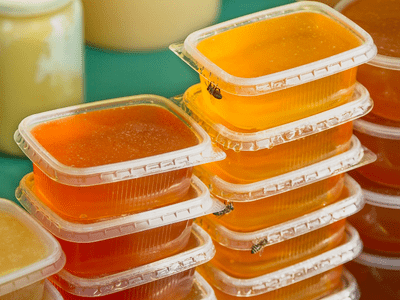Sourdough starter jars-If you’ve never made sourdough before, a sourdough starter is a live culture of flour and water that has been fermented. Once it starts to bubble and move, you add a small amount to your sourdough bread recipe to make it rise. You don’t need to use commercial yeast.
You will find more detailed writing and extra information (believe me, I could keep going!) But for now, all you need to know is that sourdough baking would not be possible without a sourdough starter.
So, what kind of container should your starter be in? Does it even matter?
From what I’ve seen, how to store sourdough depends on what the baker wants.
I’ve never heard of a container that was either good or bad, but if you ask around, I’m sure you’ll hear a lot of different things! I love it when people put their openers on Instagram or their blogs. It’s fun to see the different kinds.
Here are some jars for sourdough starter you can use:
The Best Sourdough Starter Jars
1.) Glass Jar

This is my favorite thing. I’ve stopped using plastic containers and Tupperware on my own over the years. I like glass. It’s easy to clean, and you don’t have to worry about weird chemicals getting into your starter.
Also, because glass is clear, you can see everything inside (bubbles, foamy stuff, liquids, etc.). This is a very important way to learn about your starter and what you can do to fix it, if you need to. I’ll never forget how, over the summer, a whole bunch of fruit flies moved into my jar. If I had put them in a solid container, I would have never seen them. I know it’s gross.
You can choose from mason jars, jam jars, latch top jars, and canning jars with those metal ring tops you can never find. it depends on you.
The size of the jar depends on how much starter you already have or how much you want to keep in the future. Your starter will at least double in size and may grow even more, so you’ll need a jar to hold it.
You can use a lid, plastic wrap, or even a small cloth to loosely cover it. I switch back and forth based on how I feel. Keep in mind that if the lid is on too tightly, the jar could break, and glass shards could end up in the mixture. I had to throw out the whole thing the one time this happened to me.
2.) A plastic box

Even though I like glass better, I started out with a plastic container. I didn’t have any trouble with it. From what I can remember, it was probably a small, random BPA-free Tupperware container I found in the back of my kitchen cabinet.
As I had already said, I stopped using plastic. But there’s one more reason I switched: size.
Unless you use a Chinese quart container for soup, most plastic containers are not tall. They are short and wide. I didn’t like this because it was hard to see when my starter had doubled in size, which is a visual sign that it’s ready to use.
Plastic, on the other hand, doesn’t break like glass does. It only melts if you leave it on the bottom rack of your dishwasher.
3.) Pint Jar

I use a pint glass when all of my glass jars are dirty or being used for something else. Yes, the kind you get at a bar to drink beer out of. These are great for making starters for sourdough. They are nice and tall, and you can use a cloth or plastic wrap to cover the top. Any kind of tall, large glass will do. In my kitchen, I have a stash.
4.) Crock of stoneware
I have never used this before. King Arthur Flour sells big crocks for sourdough that seem to be pretty popular. The selling point is that the material is non-reactive and the crock is easy to spot, so you won’t accidentally throw it away because it looks like pancake batter in a jar (see option #3). I don’t think these crocks will break as easily as glass, either. Even so, I still like containers that are clear so I can see what’s going on inside.
Conclusion
The important thing is to try different things to see what you like.
You might start out with a certain jar, but then find that it’s hard to clean. This might make you want to switch to something else. And that’s fine. Also, as time goes on, crusty bits of dried flour will form on top of your starter and near the lid. Even if this doesn’t happen, you’ll have to change it out when it does. So think outside the box and try out what you have!
So, what do you think? What kind of bowl do you put your sourdough starter in?